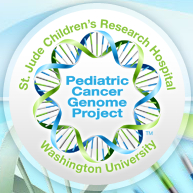Today’s plenary session included some great talks on cancer genomics. Keynote speaker Jim Downing of St. Jude Children’s Research Hospital gave a talk on acute leukemia, in which he openly admitted that he would show no next-gen sequencing data. Instead, he gave a very nice overview of the four biological processes that are dysregulated in acute leukemia:
- Self renewal. With a few exceptions, pre-leukemic cells have only limited self-renewal capacity. AML1-ETO is often altered to overcome this limitation.
- Response to growth factor signals. The BCR-ABL gene fusion is a classic example of an alteration that lets cells grow in the absence of growth factors.
- Differentiation. Leukemic cells block this process via alterations in PML-RARA, PAX5, EBF, BTLA, and others).
- Apoptosis. This normal pathway of cell death is circumvented in leukemia via alterations in CDKN2A/B, BT6, and the RB pathway.
Non-NGS Molecular Profiling
Dr. Downing’s group uses several molecular techniques to characterize pediatric leukemias, including Affy SNP-chip (for copy number alterations), cytogenetics/FISH, and targeted sequencing in a handful of genes. In a study of 242 pediatric acute lymphoblastic leukemia (ALL) tumors with matched controls, a surprisingly small number of copy number alterations were observed.
There were a few significantly altered genes, however. PAX5 was deleted or amplified in 30% of B-cell ALLs; some apparent 3′ deletions proved to be fusion events with ETV6, FOXP1, or other genes. Another gene, IK2F1, was deleted in 83.7% of ALLs that were BCR-ABL positive. These and other findings convinced the audience, I think, that there is much to be learned, even about the best-characterized human cancer, and even without next-generation sequencing technologies.
Cancer Genomes and Translational Oncology
Levi Garraway of Harvard Medical School spoke about how next-generation sequencing can be applied to translational oncology. He offered a clinical perspective to cancer genomics, which has somewhat different requirements from basic research:
- Targeted. The mutations and genes to be assessed in clinical samples must already be known and well-characterized.
- Resource-efficient. To minimize costs, clinicians are interested in tests that make efficient use of sample and equipment resources.
- Actionable. Only mutations and biomarkers that give actionable information, i.e., “the patient has X mutation, so we should administer drug Y” are valuable in a clinical setting.
A resource compiled by Dr. Garraway and others, called OncoMap, offers a database of known oncogenic mutations that can be tested (on frozen or FFPE samples) for just $200 per patient. Granted, it includes only 46 mutations from 34 cancer genes, but each provides a validated, actionable course in regard to treatment.
The speaker admitted that ideally, a systematic mutational profiling method would have high sensitivity and specificity, testing both oncogenes and tumor suppressors. It would also detect multiple alteration types (SNVs, CNAs, etc) and be able to use either DNA or RNA, or both. And it would have an “acceptable” turnaround time, say 2 weeks. This is what clinicians want, and it may be that hybrid capture approaches may offer the best solution. More on that in another post.
Elaine Mardis: Single Molecule Sequencing in Cancer
My favorite talk of the day (obviously) was by genome center co-director E laine Mardis, who presented WashU’s pipeline for detecting and validating somatic mutations from whole-genome sequencing. Our pipeline has evolved over the course of AML1, AML2, and other cancer whole-genome sequencing projects, and now has the highly automated capacity to handle the coming 600 tumor-normal pairs to be sequenced for the Pediatric Cancer Genome Project (PCGP).
laine Mardis, who presented WashU’s pipeline for detecting and validating somatic mutations from whole-genome sequencing. Our pipeline has evolved over the course of AML1, AML2, and other cancer whole-genome sequencing projects, and now has the highly automated capacity to handle the coming 600 tumor-normal pairs to be sequenced for the Pediatric Cancer Genome Project (PCGP).
Dr. Mardis also discussed our methods for systematically assessing the prevalence of somatic mutations (within a tumor population) as well as their recurrence in tumors of the same or other types. Prevalence is important because the greater fraction of tumor cells that share a mutation, the more likely it occurred early during progression. By similar reasoning, assessing the recurrence of mutations in a tumor type provides a measure of their importance for disease development.
The Importance of Recurrence Testing
IDH1 demonstrates this principle well. Initially identified as a key cancer gene in glioma by Bert Vogelstein’s group at Johns Hopkins, the isocitrate dehydrogenase 1 (IDH1) gene was also mutated in AML2, and, in a screen of hundreds of AML samples, proved to be recurrent. At least two large-scale studies of AML have since replicated the common incidence of IDH1 mutations in AML and other cancers.
Third Generation Sequencing in Cancer
Finally, the speaker presented some recent experiments that we’ve performed using the Pacific Biosystems Single Molecule Real Time sequencer on in-house cancer samples. In work that’s part of a manuscript in submission, the accuracy and sensitivity of the SMRT sequencer were assessed on GBM and AML tumor samples that had already been characterized by whole genome sequencing. In general, the results were promising – 25 of 25 known somatic mutations were identified in SMRT sequencing of PCR products, although 6 were detected at lower-than-expected prevalence.
Somatic mutations from AML2 were also used to create mixed PCR libraries of various tumor cellularities from 50% to 100%. It was apparent that “tier 1” somatic coding mutations were more reliably detected on Pac Bio than tier 2 and tier 3 mutations, and that there’s a slight bias against detecting C to T mutations. That said, the ability of SMRT sequencing to detect somatic mutations even at low tumor cellularities is promising.
Cool article, thanks for sharing.
Isn’t it 460 mutations from 34 cancer genes? (Oncomap)